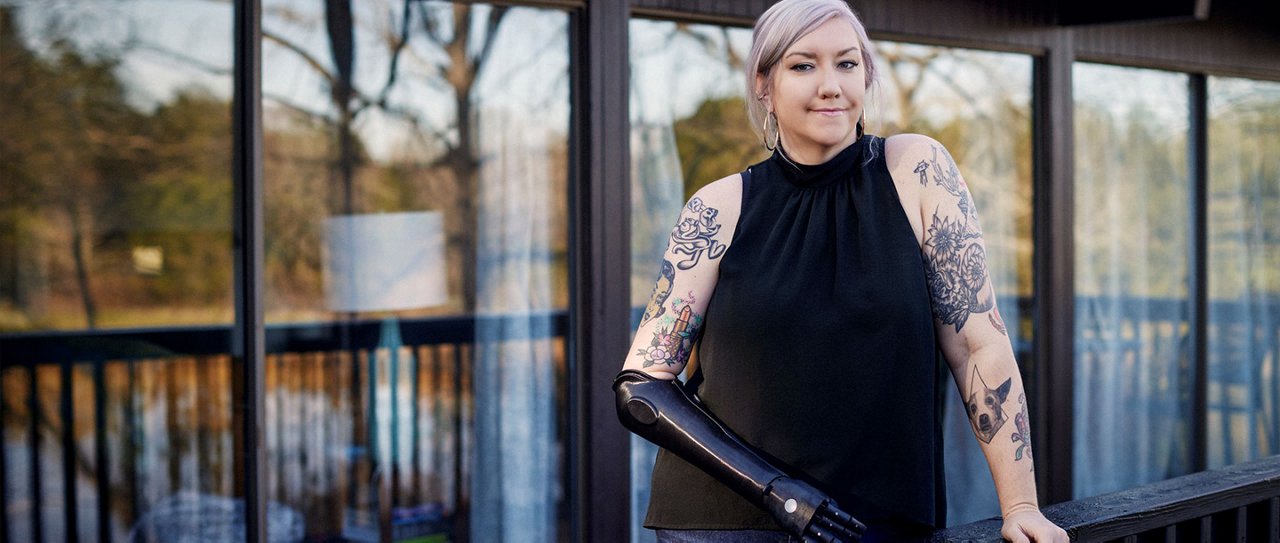Kate's 3D printed bionic arm improved her health - and her confidence

At eight years old, the prosthetic arm Kate Kehayes wore weighed almost as much as she did. She describes it as a mannequin arm – clunky, beige, made from heavy metal and ceramic.
Kate was born without her right forearm. In her childhood, having a prosthetic wasn’t helpful. But as she got older, she started to realize the barriers she was facing.
“As I got into my 30s, it just started to become more of a barrier that I couldn’t work around. I was starting to have back pain. When I was trying to do things like yoga, I was off balance,” she said. “So as I was aging, the need for it definitely became evident.”
This realization started her journey into learning more about prosthetics.
“It’s a huge life-changing decision to begin wearing a prosthetic, so there was a lot of fear and anxiety that went into the process,” she said. “I didn’t know the process of getting a prosthetic as an adult or even as a teenager because I had just gone without.”
One day while scrolling Reddit, she noticed a young woman wearing an arm by UK-based Open Bionics that actually matched her personality. It was sleek, black, high-tech – it looked like arm she would want to wear. Termed the Hero Arm, the prosthetic is 3D printed, custom-built for each patient, and capable of lifting about 18 pounds.
“When I was younger, the technology just wasn’t quite there yet,” she said. “But when I started looking into it as an adult, it was like a whole new world. So that really pulled me back into doing some research and getting in touch with Blue Cross NC.”
Blue Cross and Blue Shield of North Carolina (Blue Cross NC) connected with the Hanger Clinic, one of the first clinics to bring the Hero Arm to the United States. Kate credits the clinic, which specializes in state-of-the-art prosthetics, in helping her get the Hero Arm approved through insurance. It was a long journey, but after talking with Kate and consulting with Hanger, her Blue Cross NC policy covered the cost of her Hero Arm, which runs between $10,000 and $20,000.
Getting Kate fitted with the Hero Arm was important to providing her with excellent care in a complex health situation.
“Having health insurance was the only reason I could even think about getting a prosthetic,” Kate said. “It gave me peace of mind that I could at least give it a shot.”
She quickly learned how to use her prosthetic in everyday life. Bionic arms work by picking up signals from the user’s muscles. The special sensors in the device detect naturally generated electric signals and convert these movements into bionic hand movements.
“The hardest part is finding through trial and error what tasks I can use it for,” Kate said. “I’m discovering new ways to use it all the time. I think pushing a shopping cart was the first thing that I did that I said, ‘Oh, this feels so much better when you can actually push it from both sides and you’re not constantly trying to counterbalance it.’ It was just little things that I hadn’t experienced before that I didn’t realize were so much easier for other people.”
The biggest change that Kate noticed, though, was in her confidence. With the new Hero Arm, she started to feel more comfortable and confident in herself.
“One of the biggest changes is I always wear it in public. I’ve just found that that has made being around other people much better, because my confidence is so improved,” she said. “When I have conversations about it, it’s not awkward. I have something I’m really proud of, and people usually want to know about it.”
As Kate thinks back to her childhood, it’s still hard to talk about the way she was treated by kids at school.
“It sucked. It was a lot of ‘What’s wrong with you?’ and other condescending conversations that questioned my abilities.” But, she said, the Hero Arm has flipped the script. “That’s the thing that’s been totally flipped over. Now conversations are about ‘What can your arm do? That’s so cool. How does it work?’ The focus is on what makes me unique rather than what I lack.”
She has even found it applicable to her work as a therapist. The Hero Arm provides an opening to connect with her clients and start conversations about body image, health challenges or fitting in. She jokes that the children she works with thinks she’s as cool as Iron Man.
Now, Kate can see that strength in herself, too.
“That was the driving force of pushing through the whole process, even though it was hard. I finally connect with something that feels right, that I will actually use, and that could change my life. And it really has changed so much.”
Browse related articles


Blue Cross and Blue Shield of North Carolina does not discriminate on the basis of race, color, national origin, sex, age or disability in its health programs and activities. Learn more about our non-discrimination policy and no-cost services available to you.
Information in other languages: Español 中文 Tiếng Việt 한국어 Français العَرَبِيَّة Hmoob ру́сский Tagalog ગુજરાતી ភាសាខ្មែរ Deutsch हिन्दी ລາວ 日本語
© 2024 Blue Cross and Blue Shield of North Carolina. ®, SM Marks of the Blue Cross and Blue Shield Association, an association of independent Blue Cross and Blue Shield plans. All other marks and names are property of their respective owners. Blue Cross and Blue Shield of North Carolina is an independent licensee of the Blue Cross and Blue Shield Association.


